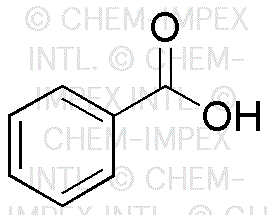Benzoic acid is widely utilized in research focused on:
- Food Preservation: It acts as a natural preservative in various food products, helping to inhibit the growth of mold, yeast, and some bacteria, thereby extending shelf life.
- Pharmaceuticals: This compound is used in the formulation of medications, particularly in topical creams and ointments, due to its antibacterial properties.
- Cosmetics: Benzoic acid is incorporated into personal care products as a pH adjuster and preservative, ensuring product stability and safety for consumers.
- Industrial Applications: It serves as a precursor in the synthesis of various chemicals, including dyes and plastics, making it essential in the manufacturing sector.
- Research and Development: In laboratories, it is used as a standard in analytical chemistry for calibrating instruments and assessing the purity of other compounds.
General Information
Properties
Safety and Regulations
Applications
Benzoic acid is widely utilized in research focused on:
- Food Preservation: It acts as a natural preservative in various food products, helping to inhibit the growth of mold, yeast, and some bacteria, thereby extending shelf life.
- Pharmaceuticals: This compound is used in the formulation of medications, particularly in topical creams and ointments, due to its antibacterial properties.
- Cosmetics: Benzoic acid is incorporated into personal care products as a pH adjuster and preservative, ensuring product stability and safety for consumers.
- Industrial Applications: It serves as a precursor in the synthesis of various chemicals, including dyes and plastics, making it essential in the manufacturing sector.
- Research and Development: In laboratories, it is used as a standard in analytical chemistry for calibrating instruments and assessing the purity of other compounds.
Documents
Safety Data Sheets (SDS)
The SDS provides comprehensive safety information on handling, storage, and disposal of the product.
Product Specification (PS)
The PS provides a comprehensive breakdown of the product’s properties, including chemical composition, physical state, purity, and storage requirements. It also details acceptable quality ranges and the product's intended applications.
Certificates of Analysis (COA)
Search for Certificates of Analysis (COA) by entering the products Lot Number. Lot and Batch Numbers can be found on a product’s label following the words ‘Lot’ or ‘Batch’.
*Catalog Number
*Lot Number
Certificates Of Origin (COO)
This COO confirms the country where the product was manufactured, and also details the materials and components used in it and whether it is derived from natural, synthetic, or other specific sources. This certificate may be required for customs, trade, and regulatory compliance.
*Catalog Number
*Lot Number
Safety Data Sheets (SDS)
The SDS provides comprehensive safety information on handling, storage, and disposal of the product.
DownloadProduct Specification (PS)
The PS provides a comprehensive breakdown of the product’s properties, including chemical composition, physical state, purity, and storage requirements. It also details acceptable quality ranges and the product's intended applications.
DownloadCertificates of Analysis (COA)
Search for Certificates of Analysis (COA) by entering the products Lot Number. Lot and Batch Numbers can be found on a product’s label following the words ‘Lot’ or ‘Batch’.
*Catalog Number
*Lot Number
Certificates Of Origin (COO)
This COO confirms the country where the product was manufactured, and also details the materials and components used in it and whether it is derived from natural, synthetic, or other specific sources. This certificate may be required for customs, trade, and regulatory compliance.


